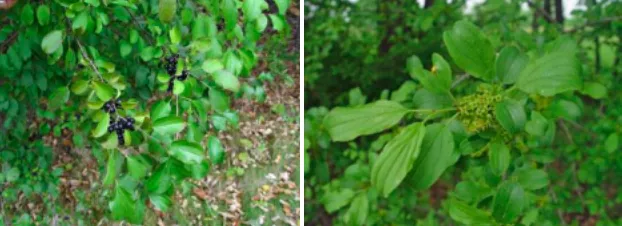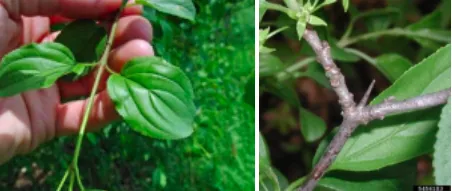by Mandy Ball for IPA (Invasive Plant Annihilation)

Photos of Common Buckthorn with flowers and berries from Maine.gov
Buckthorn is a highly invasive and aggressive deciduous tree in Maine. Common Buckthorn and Glossy Buckthorn are prevalent in all of Maine. Common Buckthorn grows in any kind of soil, in sun or shade. Glossy Buckthorn prefers wetter, sunnier areas. They both grow rapidly, reaching seed bearing age quickly. Birds readily spread the berries. Buckthorn is an allelopathic plant: The roots, leaves and berries contain a chemical that inhibits the growth of other species. They leaf out earlier in the spring and retain their leaves later into the fall, competing with and crowding out many of our native plants (including some rare species).
Common Buckthorn can be shrubby and multi-stemmed, or single trunked. It can grow to 25 feet. It has dull green oval leaves, 1” to 3” long, with fine teeth and distinct veins curved towards the leaf tip. The leaves grow alternate to nearly opposite each other. The fragrant flowers grow from among the leaves in small clusters of 4 greenish yellow petals. The berries are green to glossy black. Berries can remain viable in the soil for 6 years. Common Buckthorn may have small “thorns” in a fork between two branches (These are remnants oftwigs breaking off), and most twigs end in a ½” to 7/8” small thorn (bud). Large plants have orange/yellow inner bark.

Photo of Common Buckthorn leaf and stipules from Maine.gov
Photo of Common Buckthorn terminal “thorn” from Leslie J. Mehrhoff, University of Connecticut, Bugwood.org
Glossy Buckthorn is a very similar shrub or tree. It can be multi-stemmed, or single trunked and can grow to 20 feet. Leaves are shaped similarly, 2”-4” long, and sometimes glossy and lack teeth. Glossy Buckthorn is thornless. The flowers have 5 petals. The berries go from green to glossy black and can be red and black at the same time. Seeds are viable for at least 2 years. Roots are red.
Photo of Glossy Buckthorn with berries from Maine.gov
We do have some similar native plants:
- Alder-leaved Buckthorn: A low shrub (3’ to 5’ at maturity) that likes wetlands. The native species lacks thorns on the ends of its twigs and has small teeth on its leaves. The leaves are larger and grow opposite along the stem. The flowers have 5 petals.
- Cherry: Leaves are alternate. If you scratch the bark, or a twig, it has a characteristic almond smell.
- Winterberry Holly: Alternate leaves, bright red fruit. Likes wet soils.
- Speckled Alder: Likes swampy areas, leaves are rough. Flowers are catkins and fruit looks like a little pinecone.
None of these similar native plants have orange inner bark.
Apple trees can look somewhat similar also.
The best ways to control Common Buckthorn and Glossy Buckthorn are:
- Pull them out if they are small enough. Try not to disturb the roots of the local native plants.
- Repeated mowing or cutting. They will resprout but weaken with each cutting. Recommended cutting is 3 X per year for 3 years.
- Girdling. Cut completely through the bark and about 3 centimeters wide.
- Burning. A 5 second flame torch around the stem kills sprouts up to 4.5 centimeters in diameter. Be careful!
- Chemicals. Applied to the cut trunks have some efficacy. Foliar applications of glyphosate†are effective in late fall. Herbicides can also be applied as cut-stump applications (glyphosate or triclopyr solution applied immediately after cutting except in early spring), or basal bark application (for stems <6" diameter, triclopyr ester in bark oil). Again, be careful and follow instructions on the herbicides.
For more information: maine.gov/dacf/mnap/features/invasive_plants/rhamnus.htm
We have formed a small group of people interested in learning about invasive plants in Maine, and what we can do to help. If you’d like to join us, we meet at the Prince Memorial Library on the 3rd Thursday of the month at 6:30pm, from April through November. All are welcome!
To be added to our email list, email Mandy Ball at mandyballroomdance@gmail.com.